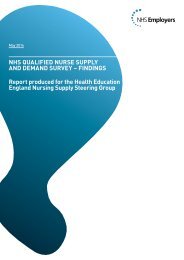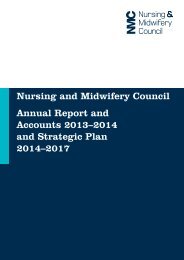Journal_1_2014_final_WEB
Journal_1_2014_final_WEB
Journal_1_2014_final_WEB
Create successful ePaper yourself
Turn your PDF publications into a flip-book with our unique Google optimized e-Paper software.
National wound care<br />
innovation centre launched in<br />
the United Kingdom<br />
Peter Vowden,<br />
Professor<br />
Clinical Director,<br />
NIHR Bradford Wound<br />
Prevention and Treatment<br />
Healthcare Technology<br />
Co-operative, the United<br />
Kingdom<br />
Correspondence:<br />
peter.vowden@<br />
bthft.nhs.uk<br />
Conflict of interest: none<br />
In January 2013, the United Kingdom’s National<br />
Institute for Health Research (NIHR)<br />
established eight new Healthcare Technology<br />
Co-operatives (HTCs) to act as centres of expertise<br />
to focus on clinical areas or themes of high<br />
morbidity and unmet needs of National Health<br />
Service (NHS) patients with the aim of fostering<br />
innovation in these areas. Working collaboratively<br />
with industry, the HTCs aim to develop<br />
new medical devices, healthcare technologies, or<br />
technology-dependent interventions, which improve<br />
patient treatment and quality of life.<br />
The eight HTCs cover a diverse array of<br />
clinical problems ranging from mental health to<br />
cardiovascular disease management. One of the<br />
key areas to benefit from the NIHR’s recognition<br />
of unmet need was wound care, with Bradford<br />
Teaching Hospital’s NHS Foundation Trust designated<br />
as the host organisation for the NIHR<br />
Wound Prevention and Treatment HTC (NIHR<br />
WoundTec HTC).<br />
Table 1: Strategic partners in the NIHR WoundTec HTC<br />
Bradford Teaching Hospital’s NHS Foundation Trust,<br />
led by Professor Peter Vowden<br />
Specialises in: Industry links, patient focus, clinical trial delivery, clinical care,<br />
and education.<br />
King’s College London,<br />
led by Dr. Patricia Grocott and Professor Glen Robert<br />
Specialises in: Clinical data capture, identification of unmet needs, co-design<br />
of novel medical devices with users and manufacturers, and proof-of-concept<br />
testing.<br />
University of Southampton, led by Professor Dan Bader<br />
Specialises in: Sensor development, device and support system assessment,<br />
and end-user evaluation.<br />
University of Leeds, led by Professors A Nelson and J Nixon<br />
Specialises in: Evidence review and clinical trial design and evaluation.<br />
University Hospital Birmingham’s NHS Foundation Trust,<br />
led by Dr. Carol Dealey, Lt Col Steven Jeffery, and Professor Sir Keith Porter<br />
Specialises in: Acute and chronic wound management, clinical trial and care<br />
evaluation, and horizon scanning.<br />
University of Bradford, led by Professors Stephen Britland (currently at<br />
University of Wolverhamptom) and Des Tobin<br />
Specialises in: Laboratory and cellular research to understand the biological<br />
action of devices.<br />
The NIHR WoundTec HTC is led by Professor<br />
Peter Vowden, the HTC’s Clinical Director,<br />
and builds on an established strategic partnership<br />
between wound care experts in King’s College<br />
Hospital London, Queen Elizabeth II Hospital<br />
Birmingham, and the universities of Leeds,<br />
Bradford, Wolverhampton, and Southampton<br />
(Table 1). Together, these experienced clinicians<br />
and academics have a proven track record<br />
in wound prevention and treatment, acute and<br />
chronic wound management, patient-focused<br />
care, patient-led device design, and clinical trial<br />
management.<br />
Towards cost-effective<br />
wound care<br />
The management and prevention of skin breakdown<br />
is a major cost burden for health care<br />
providers and a common area for litigation, yet<br />
wound prevention and treatment can often be<br />
an area of relatively unregulated clinical practice<br />
with a poor evidence base for practice. Variation in<br />
clinical outcome across a wide spectrum of health<br />
care providers and within diverse national health<br />
care systems are well recognised and have led to<br />
the adoption of pressure ulcer prevention standards<br />
and wound healing rates as quality indicators<br />
for clinical care provision.<br />
Funding constraints within all health care systems<br />
have led to increasing recognition of cost, in<br />
addition quality, as a driver for change in practice.<br />
Wound care products form a major subsector of<br />
the medical devices industry, and along with staff<br />
costs, constitute a major cost burden for healthcare<br />
providers. It is therefore understandable that development<br />
of new, “advanced”, and more effective<br />
medical devices aimed at improved wound care<br />
provision is desirable but must be achieved within<br />
the constraints of cost effectiveness. In order to<br />
aid in the understanding of current wound care<br />
60<br />
EWMA <strong>Journal</strong> <strong>2014</strong> vol 14 no 1




